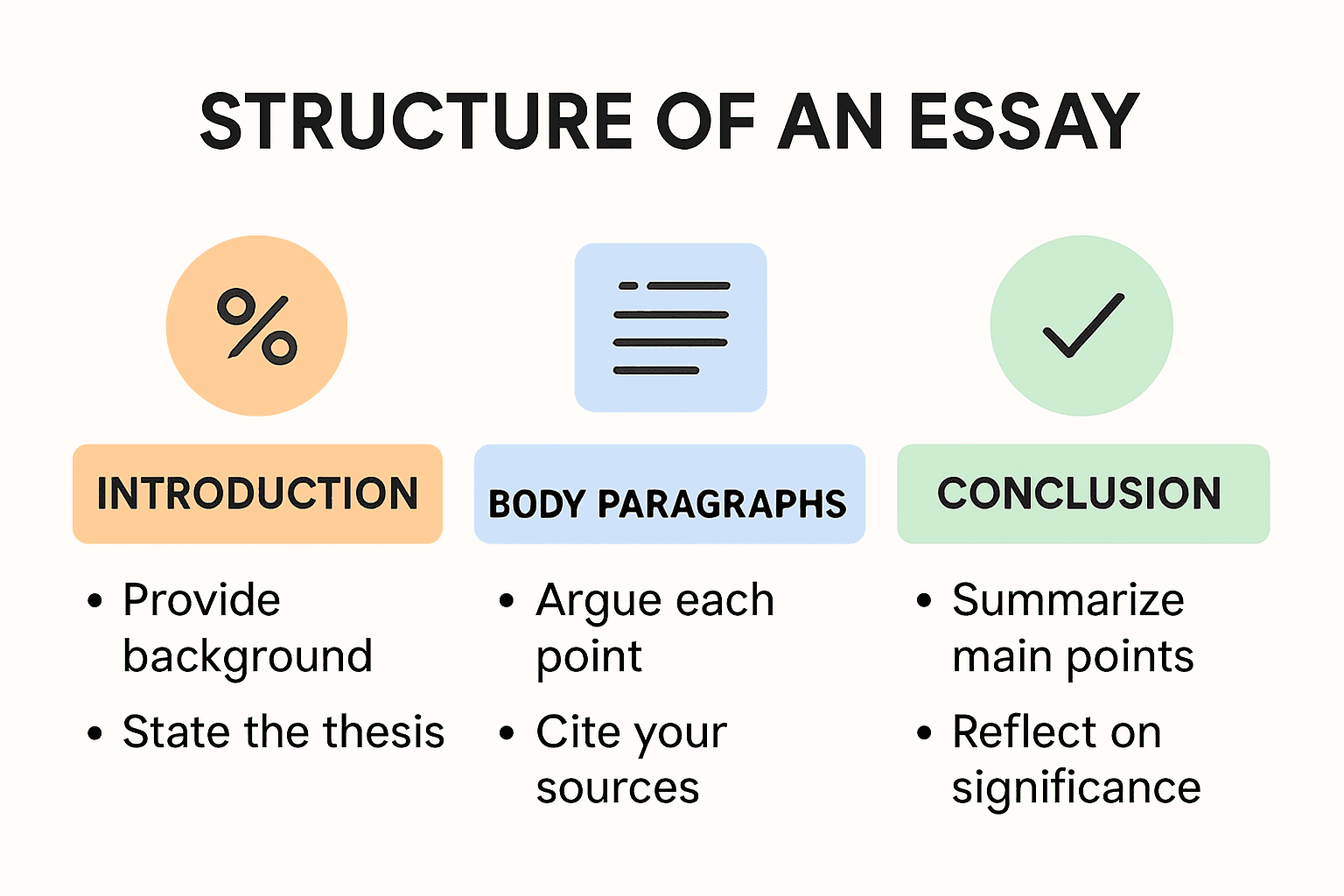Blog
Learning Materials
Essay Layout Example: A Practical Guide for 2025
Updated: June 24, 2025

A strong essay layout does more than keep your writing neat. It shapes your argument from the first word to the final sentence, guiding every step. Yet here’s the surprising fact. Most students still lose crucial points simply because of poor structure and formatting, not weak arguments. Instead of thinking the content is always king, the real winners are those who master layout basics. The details you skip today could make or break your grade tomorrow.
Table of Contents
- Structural And Organizational Errors
- Citation And Formatting Pitfalls
- Content And Argumentation Mistakes
Quick Summary
| Takeaway | Explanation |
|---|---|
| Master the Three Core Structural Elements | Every strong essay includes an introduction with a clear thesis statement, body paragraphs that provide support and evidence, and a conclusion that synthesizes the argument without introducing new information. |
| Follow a Systematic Writing Process | Begin with analytical preparation, then develop a structured approach to writing your essay, moving through introduction, body paragraphs, and conclusions with clear transitions and logical flow. |
| Adhere to Formatting Standards | Utilize consistent document formatting with a professional font, proper citation styles, and correct structural elements like a title page to enhance academic integrity and readability. |
| Avoid Common Mistakes | Be mindful of structural errors like vague thesis statements, citation inconsistencies, and weak transitions, which can distract from the overall argument and clarity of your essay. |
Essential Parts of a Strong Essay Layout
Crafting a compelling essay requires understanding its fundamental structural components. An effective essay layout serves as a roadmap that guides readers through your argument with clarity and precision. By mastering the essential parts of an essay, you transform a collection of ideas into a coherent and persuasive academic document.
The Three Core Structural Elements
Every strong essay consists of three critical sections that work together to communicate your ideas effectively. These components are not just formatting requirements but strategic frameworks for intellectual communication.
Introduction: This opening section establishes the context and presents your central argument. A powerful introduction does more than state your thesis. It captures the reader's attention, provides necessary background information, and clearly articulates the specific perspective or argument you will develop. Your thesis statement should be concise, specific, and positioned typically at the end of the introduction, serving as a roadmap for the entire essay.
Body Paragraphs: These sections form the substantive core of your essay. Each body paragraph should focus on a single main idea that directly supports your thesis. Structured effectively, body paragraphs follow a consistent pattern: begin with a clear topic sentence, provide evidence or examples, analyze that evidence, and then connect the paragraph's argument back to the overall thesis. Explore our comprehensive guide on crafting compelling essay arguments.
The progression of body paragraphs matters significantly. Start with simpler, more widely accepted claims and gradually introduce more complex or nuanced arguments. This approach helps readers follow your intellectual journey and builds credibility for your perspective.
Conclusion: The final section synthesizes your arguments and leaves a lasting impression. A robust conclusion does more than summarize. It reinforces the significance of your argument, demonstrates how your evidence proves your thesis, and potentially suggests broader implications or future areas of inquiry. Avoid introducing new information here. Instead, provide a powerful restatement of your core argument that resonates with readers.

Formatting Considerations for Academic Integrity
Beyond structural elements, proper formatting communicates academic professionalism. According to research from academic writing experts, consistent formatting signals scholarly rigor. This includes:
- Standardized Typography: Use a professional font like Times New Roman, size 12, with 1.5 line spacing
- Citation Style Adherence: Follow a specific style guide (APA, MLA, Chicago) meticulously
- Title Page Precision: Include all required institutional or publication information
By understanding and implementing these essential parts of an essay layout, you transform your writing from a mere collection of words into a structured, persuasive academic communication. Each section plays a crucial role in presenting your intellectual argument with clarity, coherence, and impact.
Step-by-Step Essay Layout Example for Students
Creating a well-structured essay requires a systematic approach that transforms abstract ideas into a clear, compelling academic document. This step-by-step guide provides students with a practical framework for developing an effective essay layout that maximizes clarity and impact.
Preliminary Planning and Preparation
Before diving into writing, successful essay composition begins with strategic preparation. Start by carefully analyzing the essay prompt, identifying key requirements, and understanding the specific expectations. Check out our detailed guide for creating a robust essay outline.
Key preparatory steps include:
- Research Collection: Gather credible sources and academic materials
- Thesis Development: Craft a clear, focused central argument
- Brainstorming: Generate ideas and potential supporting arguments
According to academic writing experts, the initial planning phase is crucial for organizing your thoughts and establishing a solid foundation for your essay.

Structured Writing Process
Once preparation is complete, follow this systematic approach to essay construction:
Step 1: Introduction Development
- Begin with a compelling hook to capture reader attention
- Provide necessary background context
- Present your thesis statement clearly and concisely
- Outline the main arguments you will explore
Step 2: Body Paragraph Construction
- Create 3-5 body paragraphs depending on essay length and complexity
- Each paragraph should focus on a single primary argument
- Start with a strong topic sentence
- Include evidence, analysis, and direct connections to your thesis
- Use transitional phrases to maintain logical flow between paragraphs
Step 3: Conclusion Crafting
- Restate your thesis in a new way
- Summarize key arguments without simply repeating earlier content
- Provide broader context or implications of your argument
- End with a memorable statement that reinforces your central message
Final Refinement and Formatting
The last stage of essay layout involves critical review and professional formatting. Ensure your document meets academic standards by:
- Checking citation formatting (APA, MLA, or Chicago style)
- Verifying consistent font and spacing (typically Times New Roman, 12pt, 1.5 line spacing)
- Proofreading for grammatical and structural coherence
- Confirming all sources are properly referenced
By following this systematic approach, students can transform their initial ideas into a well-structured, persuasive academic essay. Remember that practice and attention to detail are key to mastering the art of essay writing.
Formatting Tips for Academic and Research Papers
Formatting plays a critical role in academic writing, serving as a visual representation of scholarly precision and professionalism. While content remains paramount, adhering to specific formatting guidelines demonstrates academic rigor and ensures your research is presented with clarity and credibility.
Standard Document Formatting
The foundation of academic paper formatting lies in consistent and professional document design. Explore our comprehensive guide to academic writing standards.
Key standard formatting requirements include:
- Font Selection: Use Times New Roman, 12-point size for optimal readability
- Margins: Maintain 1-inch margins on all sides of the document
- Line Spacing: Utilize double spacing throughout the entire document
- Page Numbering: Include page numbers in the top right corner of each page
According to academic writing experts, these formatting elements create a uniform appearance that allows readers to focus on your research content.
Citation and Reference Guidelines
Precise citation formatting distinguishes academic writing from other forms of communication. Different disciplines require specific citation styles, with APA, MLA, and Chicago being the most common.
APA Style Specifics:
- Use a hanging indent for reference list entries
- Alphabetize references by the first author's last name
- Include DOI numbers for digital sources when available
- Provide complete publication information
MLA Style Considerations:
- Center the paper title
- Use last name and page number in the header
- Include a works cited page with precise formatting
- Ensure consistent parenthetical citations
Chicago Style Requirements:
- Utilize footnotes or endnotes for source attribution
- Include a comprehensive bibliography
- Provide full publication details for each source
Title Page and Structural Formatting
The title page represents your first opportunity to demonstrate professional academic presentation. According to academic formatting guidelines, a well-constructed title page should include:
- Paper title centered one-third down the page
- Author's full name
- Institutional affiliation
- Course information
- Date of submission
- Instructor's name
Additional structural considerations include:
- Consistent heading levels
- Clear section demarcations
- Appropriate use of white space
- Professional font choices
Remember that formatting is more than aesthetic preference. It communicates respect for academic conventions and demonstrates your commitment to scholarly communication. While rules might seem restrictive, they provide a universal language that enables researchers worldwide to share and understand complex ideas efficiently.
Mastering these formatting guidelines transforms your academic writing from a simple document to a professional, credible piece of scholarly communication.
Common Mistakes to Avoid in Essay Layouts
Navigating the complex landscape of academic writing requires awareness of potential pitfalls that can undermine your essay's effectiveness. Understanding and avoiding common mistakes in essay layout can significantly improve the clarity, coherence, and overall impact of your academic work.
Structural and Organizational Errors
Structural integrity forms the backbone of any successful essay. Discover strategies for maintaining academic writing precision, and be mindful of these critical organizational mistakes:
Lack of Clear Thesis
- Vague or overly broad thesis statements
- Failing to clearly articulate your central argument
- Thesis that does not directly relate to essay content
Poor Paragraph Organization
- Paragraphs without clear topic sentences
- Inconsistent paragraph length
- Lack of logical progression between paragraphs
According to academic writing experts, disorganized essays can confuse readers and weaken your argument's persuasiveness.
Citation and Formatting Pitfalls
Citation and formatting errors can significantly diminish the academic credibility of your work. Critical mistakes include:
Citation Errors
- Inconsistent citation style
- Incomplete reference information
- Improper in-text citations
- Plagiarism through inadequate source attribution
Formatting Inconsistencies
- Incorrect margin sizes
- Inconsistent font usage
- Improper line spacing
- Neglecting page numbering
- Failure to follow specific style guide requirements
Content and Argumentation Mistakes
Beyond structural issues, content-related errors can undermine your essay's effectiveness:
Weak Argumentation
- Unsupported claims
- Lack of evidence
- Emotional rather than logical arguments
- Failure to address counterarguments
Transitional Weakness
- Abrupt paragraph shifts
- Missing logical connections between ideas
- Unclear progression of arguments
Proper transitions are crucial. Research indicates that poor transitions disrupt the essay's flow and make it challenging for readers to follow your intellectual journey.
By recognizing and addressing these common mistakes, students can transform their essays from mediocre drafts to compelling academic documents. Attention to detail, careful planning, and a commitment to clear, logical communication are key to creating outstanding academic writing.
Frequently Asked Questions
What are the essential parts of a strong essay layout?
A strong essay layout includes three core elements: an introduction with a clear thesis statement, body paragraphs that support your argument with evidence, and a conclusion that synthesizes your points without adding new information.
How should I format my essay for academic integrity?
To ensure academic integrity, use a professional font like Times New Roman, size 12, with 1-inch margins, and adhere to specific citation styles such as APA or MLA. Make sure your title page includes all required information and that your document maintains consistent formatting throughout.
What common mistakes should I avoid in my essay layout?
Avoid structural and organizational errors such as vague thesis statements, poorly organized paragraphs, and inconsistent citation practices. Additionally, steer clear of weak argumentation and poor transitions that can confuse readers.
How can I improve my essay's argumentation?
To improve your essay's argumentation, present supported claims backed by credible evidence, ensure logical connections between paragraphs, and address counterarguments. Strong topic sentences and clear transitions will also enhance the flow of your argument.
Transform Your Essay Layout Into Top Grades—No More Missed Points
Struggling to organize your ideas, format paragraphs, or follow strict citation rules in your essays? You are not alone. Many students, just like you, lose valuable marks not because of weak research, but due to unclear essay structure or missed formatting details. Imagine being able to breeze through those MLA or APA guidelines, create powerful thesis statements, and keep academic integrity in check—all with less stress.

Let Samwell.ai show you a smarter way. With features like Guided Essays for building outlines, a powerful editor for perfecting every section, and real-time plagiarism checks, you gain the clarity and confidence you need for every project. Join over a million students who already trust Samwell.ai to elevate their work.
Ready to improve your next essay layout instantly? Try Samwell.ai now and see how easy academic writing can feel. Your structure, your confidence, your best results—start today.
Recommended Articles
Generate essays with Samwell.ai
Whether you’re a publisher, professor, journalist, or student, let us tailor a plan just for you.Most Read Articles

Your Guide to Help Writing a Essay Successfully
Expert tips for help writing a essay - from crafting a thesis to structuring your essay effectively.

How to Write Critical Thinking Essay: Expert Tips
Expert tips for writing a critical thinking essay. Learn how to structure, choose topics, and use evidence effectively.'

How to Write a Good Hook: A Step-by-Step Guide
Master the art of crafting a good hook with our guide. Create compelling openers for a memorable first impression.
